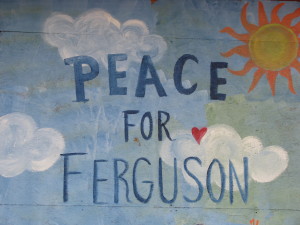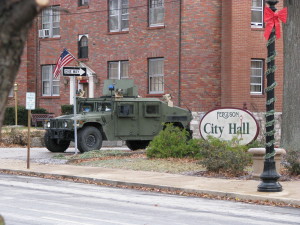
By: Christine Morabito – December 2014
The 21,000 residents of Ferguson, Missouri have been unwitting pawns in a game where everybody loses. Over the past several months, racial unrest has caused an unwelcome invasion of anarchists, Occupiers, Communist agitators, race-baiters, convicted felons, and otherwise petty criminals, who refuse to let the facts get in the way of a good riot.
One thing is clear: there is a distinct difference between the peaceful protestors and the rioters. This was especially apparent on that fateful night of Monday, November 24, when the grand jury found no probable cause to indict police officer Darren Wilson for the killing of Michael Brown.
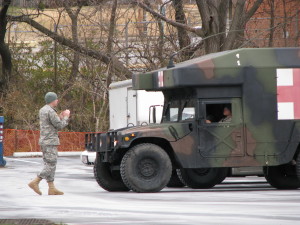
The protests aside, nothing excuses those bent on creating mayhem. Exhibit A: Michael Brown’s mother’s boyfriend, Louis Head, who grabbed a microphone and screamed “Burn this b**ch down!” And that they did, as fiery chaos soon ensued. That night more than a dozen businesses, private vehicles and police cars were set ablaze or otherwise vandalized. Rioters pelted police with bricks, rocks and bottles, some filled with urine. Other coordinated criminal acts included forming human chains to block roads and interstates. Within hours, similar scenes were replicated all over the country.
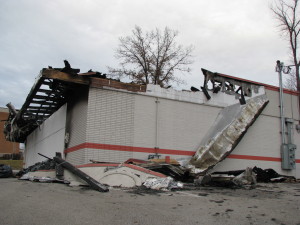 The Blaze reported that Gregory Lee Johnson, Chicago anarchist and member of the Revolutionary Communist Party, was photographed with others lighting Molotov cocktails and stoking the flames via megaphone (watch video) , encouraging the crowd to intentionally defy police. Other foreign agitators included members of the New Black Panther Party, arrested for planning to bomb the Gateway arch and kill police. Even ISIS joined the fray, offering to assist rioters through Twitter messages, if only they would first convert to Islam. Sharing the blame for exploiting this crisis was Al Sharpton – well, for being Al Sharpton.
The Blaze reported that Gregory Lee Johnson, Chicago anarchist and member of the Revolutionary Communist Party, was photographed with others lighting Molotov cocktails and stoking the flames via megaphone (watch video) , encouraging the crowd to intentionally defy police. Other foreign agitators included members of the New Black Panther Party, arrested for planning to bomb the Gateway arch and kill police. Even ISIS joined the fray, offering to assist rioters through Twitter messages, if only they would first convert to Islam. Sharing the blame for exploiting this crisis was Al Sharpton – well, for being Al Sharpton.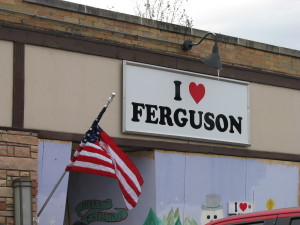
Meanwhile, local community leaders and clergy members of all races and denominations pleaded for calm, consoling the innocent victims — the residents, cowering inside their homes, the children, for whom school was cancelled, and the businesses (many black-owned) who were vandalized, burnt to the ground, or forced to close due to unrest and uncertainty.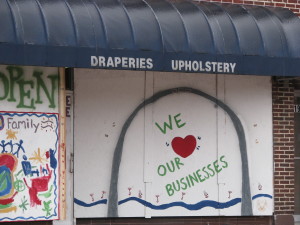
I visited Ferguson less than a week later and expected to find a city in ruin. What I found instead filled me with hope. Surprisingly forgiving were the area businesses, forced to board up their windows, either because of vandalism or to prevent it. Making the best of their lot, locals expressed themselves through art. Hence, powerful messages and murals now adorn the otherwise unsightly plywood walls. Yard signs reading “I love Ferguson” were everywhere. Churches used their marquees to advertize prayers of forgiveness and peace. No doubt, many wish the world had never heard of Ferguson, Missouri.